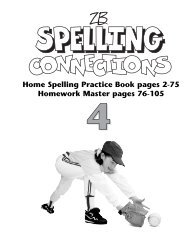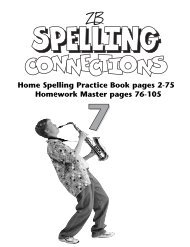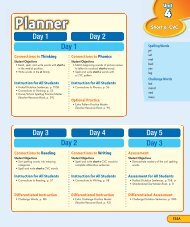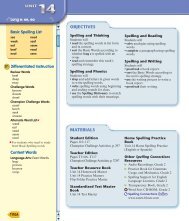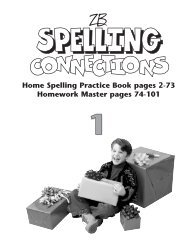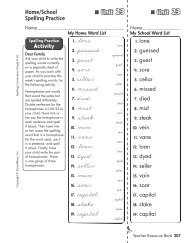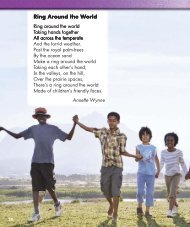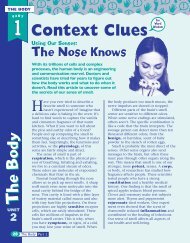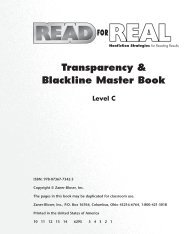Transparency & Blackline Master Book - Zaner-Bloser
Transparency & Blackline Master Book - Zaner-Bloser
Transparency & Blackline Master Book - Zaner-Bloser
You also want an ePaper? Increase the reach of your titles
YUMPU automatically turns print PDFs into web optimized ePapers that Google loves.
<strong>Transparency</strong> &<br />
<strong>Blackline</strong> <strong>Master</strong> <strong>Book</strong><br />
ISBN: 978-07367-7347-8<br />
Copyright © <strong>Zaner</strong>-<strong>Bloser</strong>, Inc.<br />
FOR<br />
Level H<br />
The pages in this book may be duplicated for classroom use.<br />
Nonfiction Strategies for Reading Results<br />
<strong>Zaner</strong>-<strong>Bloser</strong>, Inc., P.O. Box 16764, Columbus, Ohio 43216-6764, 1-800-421-3018<br />
Printed in the United States of America<br />
10 11 12 13 14 6295 5 4 3 2 1
School to Home Letter<br />
Unit 1<br />
Practice the Strategy<br />
Scaffolded Network Tree for Medical Detectives:<br />
In Search of Microscopic Suspects . . . . . . . . . . . . . . . . . . . . . . . . . . .<strong>Transparency</strong> & BLM 1<br />
Answer Key<br />
Apply the Strategy<br />
Network Tree for Curing the Common Cold . . . . . . . . . . . . . . . . . . . . . . .<strong>Transparency</strong> & BLM 2<br />
Unit 2<br />
Practice the Strategy<br />
Scaffolded Time Line for Olympic Traditions . . . . . . . . . . . . . . . . . . . . . . .<strong>Transparency</strong> & BLM 3<br />
Answer Key<br />
Apply the Strategy<br />
Time Line for “Swifter, Higher, Stronger” . . . . . . . . . . . . . . . . . . . . . . . . .<strong>Transparency</strong> & BLM 4<br />
Answer Key<br />
Unit 3<br />
Practice the Strategy<br />
Scaffolded Outline for In Search of Jamestown . . . . . . . . . . . . . . . . . . . . .<strong>Transparency</strong> & BLM 5<br />
Answer Key<br />
Apply the Strategy<br />
Outline for Urban Archaeology: Peeling the Big Apple . . . . . . . . . . . . . .<strong>Transparency</strong> & BLM 6<br />
Answer Key<br />
Unit 4<br />
Practice the Strategy<br />
Scaffolded Cause-and-Effect Chart for Valuing “Varmints” . . . . . . . . . . . . .<strong>Transparency</strong> & BLM 7<br />
Answer Key<br />
Apply the Strategy<br />
Cause-and-Effect Chart for DDT and the Peregrine Falcon . . . . . . . . . . . .<strong>Transparency</strong> & BLM 8<br />
Answer Key<br />
Unit 5<br />
Practice the Strategy<br />
Scaffolded Sequence of Events Chain for The Acosta Family . . . . . . . . . . .<strong>Transparency</strong> & BLM 9<br />
Answer Key<br />
Apply the Strategy<br />
Sequence of Events Chain for One More Border: The True Story of<br />
One Family’s Escape From War-Torn Europe . . . . . . . . . . . . . . . . . . .<strong>Transparency</strong> & BLM 10<br />
Answer Key<br />
Unit 6<br />
Practice the Strategy<br />
Table of Contents<br />
Answer Key<br />
Scaffolded Series of Events Chain for Medicine in the New Millennium . .<strong>Transparency</strong> & BLM 11<br />
Answer Key<br />
Apply the Strategy<br />
Series of Events Chain for Space Colonies: Our Future Home? . . . . . . . . .<strong>Transparency</strong> & BLM 12<br />
Answer Key<br />
K-W-L Chart . . . . . . . . . . . . . . . . . . . . . . . . . . . . . . . . . . . . . . . . . . . . . . . . . .<strong>Transparency</strong> & BLM 13<br />
Suggestions<br />
for<br />
Use<br />
Strategy Transfer Chart . . . . . . . . . . . . . . . . . . . . . . . . . . . . . . . . . . . . . . . . .<strong>Transparency</strong> & BLM 14<br />
Suggestions<br />
for<br />
Use
Dear Family,<br />
School to Home<br />
Good reading comprehension is of vital importance to your son or daughter. Nonfiction<br />
textbooks in science, social studies, and math can be especially challenging. In addition,<br />
standardized tests demand that students read and understand quickly. Outside of the<br />
classroom, the challenge continues as students read magazines, newspapers, instructions,<br />
and other types of nonfiction material.<br />
Your child is currently using Read for Real: Nonfiction Strategies for Reading Results.<br />
This program teaches valuable reading comprehension strategies to help students become<br />
better nonfiction readers. Here is a list of the strategies and how they work:<br />
When to Use the Strategy What the Strategy Says What the Strategy Means<br />
Please discuss the strategies with your son or daughter while he/she is doing homework.<br />
You might even use some of the strategies as you and your child discuss television<br />
shows, movies, and newspaper or magazine articles.<br />
Thanks for your help!<br />
Sincerely,<br />
Before Reading<br />
During Reading<br />
After Reading<br />
Preview the Selection<br />
before you begin to read.<br />
Activate Prior Knowledge<br />
about the topic.<br />
Look at the pictures, headings, etc., to<br />
get an idea of what it will be about.<br />
Think about what you already<br />
know about the topic.<br />
Set a Purpose for reading. Decide what you want to learn as<br />
you read.<br />
Make Connections with<br />
what you are reading.<br />
Interact With the Text<br />
as you read.<br />
Clarify Understanding<br />
of what you are reading.<br />
Think about how your life and knowledge<br />
fit in with what you are reading.<br />
Ask and answer questions about<br />
what you’re reading.<br />
If something doesn’t make sense,<br />
look for clues to help it make sense.<br />
Recall what you just read. Try to remember key facts<br />
or ideas.<br />
Evaluate the selection. Decide whether the selection was<br />
based on facts.<br />
Respond to what you read. Form your own opinion about<br />
what you’ve read.
Copyright © <strong>Zaner</strong>-<strong>Bloser</strong>, Inc.<br />
Level H<br />
Scaffolded Network Tree for<br />
Unit Medical Detectives: In Search<br />
1 of Microscopic Suspects<br />
Practice<br />
Louis Pasteur<br />
He vaccinated his<br />
first human patient<br />
successfully in 1885.<br />
Network Tree<br />
Medical<br />
Detectives<br />
The CDC is<br />
important in the<br />
education and<br />
prevention of<br />
viruses, like HIV.<br />
The CDC<br />
investigates new<br />
diseases in hopes of<br />
protecting people<br />
from getting them.<br />
<strong>Transparency</strong> & BLM #1
Level H<br />
Unit<br />
1<br />
Practice<br />
He developed a<br />
vaccine to cure<br />
rabies.<br />
Possible Answers for<br />
<strong>Transparency</strong> & BLM #1<br />
Scaffolded Network Tree for<br />
Medical Detectives: In Search<br />
of Microscopic Suspects<br />
Network Tree<br />
Medical<br />
Detectives<br />
Louis Pasteur CDC<br />
He vaccinated his<br />
first human patient<br />
successfully in 1885.<br />
Pasteur vaccinated a<br />
dog, his first<br />
success.<br />
The CDC is<br />
important in the<br />
education and<br />
prevention of<br />
viruses, like HIV.<br />
The CDC<br />
investigates new<br />
diseases in hopes of<br />
protecting people<br />
from getting them.<br />
When an outbreak<br />
occurs, the CDC first<br />
tries to link clues.<br />
Copyright © <strong>Zaner</strong>-<strong>Bloser</strong>, Inc.
Copyright © <strong>Zaner</strong>-<strong>Bloser</strong>, Inc.<br />
Level H<br />
Unit<br />
1<br />
Apply<br />
Network Tree for<br />
Curing the Common Cold<br />
Network Tree<br />
Curing the<br />
Common Cold<br />
<strong>Transparency</strong> & BLM #2
Level H<br />
Unit<br />
1<br />
Apply<br />
Colds are caused by<br />
viruses.<br />
Possible Answers for<br />
<strong>Transparency</strong> & BLM #2<br />
Network Tree for<br />
Curing the Common Cold<br />
What is the<br />
common cold?<br />
A cold virus can’t<br />
live on its own. It<br />
lives within cells.<br />
You “catch” a cold<br />
by inhaling the virus<br />
someone coughed or<br />
sneezed out.<br />
Network Tree<br />
Curing the<br />
Common Cold<br />
People who use a<br />
nose spray invented<br />
in the 1990s don’t<br />
get as sick as<br />
other people.<br />
Wash your<br />
hands.<br />
Can we cure the<br />
common cold?<br />
Until there is a cure<br />
Cover your<br />
mouth.<br />
Interferon also<br />
naturally fights<br />
disease.<br />
Throw away<br />
tissues.<br />
Copyright © <strong>Zaner</strong>-<strong>Bloser</strong>, Inc.
Copyright © <strong>Zaner</strong>-<strong>Bloser</strong>, Inc.<br />
Level H<br />
Unit<br />
2<br />
Practice<br />
1920<br />
1936<br />
1948<br />
Scaffolded Time Line for<br />
Olympic Traditions<br />
Time Line<br />
Olympic Traditions<br />
The Olympic flag first flew.<br />
The first torch relay happened.<br />
The Paralympics began.<br />
<strong>Transparency</strong> & BLM #3
Level H<br />
Unit<br />
2<br />
Practice<br />
Possible Answers for<br />
<strong>Transparency</strong> & BLM #3<br />
1920<br />
1932<br />
1936<br />
1948<br />
Scaffolded Time Line for<br />
Olympic Traditions<br />
1956<br />
1957<br />
1968<br />
Time Line<br />
Olympic Traditions<br />
The Olympic flag first flew.<br />
The Olympic torch first used.<br />
The first torch relay happened.<br />
The Paralympics began.<br />
The athletes first socialized at the closing ceremonies.<br />
The IOC adopted the Olympic oath.<br />
The Special Olympics began.<br />
Copyright © <strong>Zaner</strong>-<strong>Bloser</strong>, Inc.
Copyright © <strong>Zaner</strong>-<strong>Bloser</strong>, Inc.<br />
Level H<br />
Unit<br />
2<br />
Apply<br />
Time Line for<br />
“Swifter, Higher, Stronger”<br />
Time Line<br />
“Swifter, Higher, Stronger”<br />
<strong>Transparency</strong> & BLM #4
Level H<br />
Unit<br />
2<br />
Apply<br />
Possible Answers for<br />
<strong>Transparency</strong> & BLM #4<br />
Time Line for<br />
“Swifter, Higher, Stronger”<br />
1912<br />
1920<br />
1932<br />
1960<br />
1972<br />
1988<br />
Time Line<br />
“Swifter, Higher, Stronger”<br />
Jim Thorpe won gold medals in the pentathlon<br />
and the decathlon.<br />
Eddie Eagan won gold in the Summer Games.<br />
Babe Didrikson Zaharias won 3 Olympic medals.<br />
Wilma Rudolph won 3 gold medals.<br />
Mark Spitz won 7 gold medals.<br />
Jackie Joyner-Kersee won 2 gold medals.<br />
Copyright © <strong>Zaner</strong>-<strong>Bloser</strong>, Inc.
Copyright © <strong>Zaner</strong>-<strong>Bloser</strong>, Inc.<br />
Level H<br />
Unit<br />
3<br />
Practice<br />
Scaffolded Outline for<br />
In Search of Jamestown<br />
Outline<br />
In Search of Jamestown<br />
I. Introduction<br />
A. One hundred men and four boys traveled to America in search of money<br />
and settlement.<br />
B.<br />
C.<br />
II. Body<br />
A.<br />
1.<br />
2. Many passengers were ill and died.<br />
3.<br />
4. The Englishmen dealt with poison ivy, snakes, and insects.<br />
B. Archaeologist Bill Kelso looked for proof of the location of James Fort.<br />
1. Soil stains allowed investigators to locate and plot the location<br />
of the fort.<br />
2. Artifacts and skeletons were found to indicate the people of James<br />
Fort had hard times.<br />
3.<br />
III. Conclusion<br />
A. Kelso obtained enough facts to prove that he found the location of<br />
Fort James.<br />
B. September 12, 1996, was declared James Fort Day.<br />
<strong>Transparency</strong> & BLM #5
Level H<br />
Unit<br />
3<br />
Practice<br />
Possible Answers for<br />
<strong>Transparency</strong> & BLM #5<br />
Scaffolded Outline for<br />
In Search of Jamestown<br />
Outline<br />
In Search of Jamestown<br />
I. Introduction<br />
A. One hundred men and four boys traveled to America in search of money<br />
and settlement.<br />
B. The fort they established disappeared.<br />
C. Archaeologists tried to solve mystery of disappearance.<br />
II. Body<br />
A. The English who traveled to America faced many dangers.<br />
1. Ships were often lost at sea.<br />
2. Many passengers were ill and died.<br />
3. American Indians fought them to defend the land.<br />
4. The Englishmen dealt with poison ivy, snakes, and insects.<br />
B. Archaeologist Bill Kelso looked for proof of the location of James Fort.<br />
1. Soil stains allowed investigators to locate and plot the location<br />
of the fort.<br />
2. Artifacts and skeletons were found to indicate that the people of<br />
James Fort had hard times.<br />
3. Other artifacts showed that the settlers must have had free time<br />
to enjoy.<br />
III. Conclusion<br />
A. Kelso obtained enough facts to prove that he found the location of<br />
Fort James.<br />
B. September 12, 1996, was declared James Fort Day.<br />
Copyright © <strong>Zaner</strong>-<strong>Bloser</strong>, Inc.
Copyright © <strong>Zaner</strong>-<strong>Bloser</strong>, Inc.<br />
Level H<br />
Unit<br />
3<br />
Apply<br />
I.<br />
II.<br />
III.<br />
Outline for<br />
Urban Archaeology:<br />
Peeling the Big Apple<br />
Outline<br />
A.<br />
B. Archaeologists have been excavating an area in New York City since<br />
the 1990s.<br />
A.<br />
B.<br />
C.<br />
A.<br />
B.<br />
Urban Archaeology: Peeling the Big Apple<br />
1. The African Burial Ground contained free and enslaved<br />
African Americans.<br />
2.<br />
3.<br />
1. The Five Points neighborhood housed commercial, industrial,<br />
and residential areas.<br />
2. Immigrants from Germany, Ireland, and Italy made up the<br />
Five Points community.<br />
1.<br />
2.<br />
<strong>Transparency</strong> & BLM #6
Level H<br />
Unit<br />
3<br />
Apply<br />
Possible Answers for<br />
<strong>Transparency</strong> & BLM #6<br />
Outline for<br />
Urban Archaeology:<br />
Peeling the Big Apple<br />
Outline<br />
Urban Archaeology: Peeling the Big Apple<br />
I. Introduction<br />
A. Archaeology is the study of ancient civilization.<br />
B. Archaeologists have been excavating an area in New York City since<br />
the 1990s.<br />
II. Body<br />
A. 1700s<br />
1. The African Burial Ground contained free and enslaved<br />
African Americans.<br />
2. Archaeologists found human remains and artifacts.<br />
3. The location became a historical landmark in 2003.<br />
B. 1800s<br />
1. The Five Points neighborhood housed commercial, industrial,<br />
and residential areas.<br />
2. Immigrants from Germany, Ireland, and Italy made up the<br />
Five Points community.<br />
C. 1900s<br />
1. The World Trade Center opened in 1973.<br />
2. It was seen as a national landmark.<br />
III. Conclusion<br />
A. Archaeologists study objects from the past.<br />
B. The scientists discovered how one neighborhood changed<br />
throughout history.<br />
Copyright © <strong>Zaner</strong>-<strong>Bloser</strong>, Inc.
Copyright © <strong>Zaner</strong>-<strong>Bloser</strong>, Inc.<br />
Level H<br />
Unit<br />
4<br />
Practice<br />
Scaffolded Cause-and-Effect Chart for<br />
Causes<br />
American Indians hunted<br />
passenger pigeons.<br />
People cut down forests to<br />
make room for farmland.<br />
Prairie dogs are poisoned<br />
and exterminated.<br />
Prairie dogs’ constant<br />
chewing of grass helps new<br />
grass and plants grow.<br />
Valuing “Varmints”<br />
Cause-and-Effect Chart<br />
Valuing “Varmints”<br />
Effects<br />
The passenger pigeon<br />
population decreased.<br />
The pigeons moved west in<br />
search of food.<br />
<strong>Transparency</strong> & BLM #7
Level H<br />
Unit<br />
4<br />
Practice<br />
Possible Answers for<br />
<strong>Transparency</strong> & BLM #7<br />
Scaffolded Cause-and-Effect Chart for<br />
Causes<br />
American Indians hunted<br />
passenger pigeons.<br />
People cut down forests to<br />
make room for farmland.<br />
Prairie dogs are poisoned<br />
and exterminated.<br />
Prairie dogs’ constant<br />
chewing of grass helps new<br />
grass and plants grow.<br />
Valuing “Varmints”<br />
Cause-and-Effect Chart<br />
Valuing “Varmints”<br />
Effects<br />
The passenger pigeon<br />
population decreased.<br />
The pigeons moved west in<br />
search of food.<br />
The black-tailed prairie dog is<br />
an endangered species.<br />
Prairie dogs help provide food<br />
for other animals.<br />
Copyright © <strong>Zaner</strong>-<strong>Bloser</strong>, Inc.
Copyright © <strong>Zaner</strong>-<strong>Bloser</strong>, Inc.<br />
Level H<br />
Unit<br />
4<br />
Apply<br />
Causes<br />
Cause-and-Effect Chart for<br />
DDT and the Peregrine Falcon<br />
Cause-and-Effect Chart<br />
DDT and the Peregrine Falcon<br />
Effects<br />
<strong>Transparency</strong> & BLM #8
Level H Cause-and-Effect Chart for<br />
DDT and the Peregrine Falcon<br />
Unit<br />
4<br />
Apply<br />
Causes<br />
Egg collectors took peregrine<br />
eggs from the nest.<br />
DDT caused the peregrine<br />
eggshells to become thin.<br />
Smaller mammals ate<br />
insects that were carrying<br />
the DDT, then the peregrine<br />
would eat them.<br />
Since 1970, a few thousand<br />
falcons have been released<br />
into the wild.<br />
Possible Answers for<br />
<strong>Transparency</strong> & BLM #8<br />
Cause-and-Effect Chart<br />
DDT and the Peregrine Falcon<br />
Effects<br />
The falcon population<br />
decreased.<br />
The mother bird would crush<br />
the eggs when she sat on<br />
them, then would eat the<br />
remains.<br />
The DDT harmed the peregrines’<br />
reproductive system.<br />
The species is re-establishing<br />
itself.<br />
Copyright © <strong>Zaner</strong>-<strong>Bloser</strong>, Inc.
Copyright © <strong>Zaner</strong>-<strong>Bloser</strong>, Inc.<br />
Level H<br />
Unit<br />
5<br />
Practice<br />
Topic–<br />
First Event–<br />
Next Event–<br />
Next Event–<br />
Next Event–<br />
Final Event–<br />
Scaffolded Sequence of Events Chain for<br />
The Acosta Family<br />
Sequence of Events Chain<br />
The Acosta Family<br />
The Acosta family emigrated from Mexico to the<br />
United States.<br />
The Acosta family came to San Antonio, Texas, in 1920.<br />
The Acosta family left Mexico to escape the Mexican<br />
Revolution.<br />
Guadelupe decided to start a music store.<br />
Mike began working in the store in 1956.<br />
The Acostas want to carry on their family traditions with<br />
future generations.<br />
<strong>Transparency</strong> & BLM #9
Level H Scaffolded Sequence of Events Chain for<br />
The Acosta Family<br />
Unit<br />
5<br />
Practice<br />
Topic–<br />
First Event–<br />
Next Event–<br />
Next Event–<br />
Next Event–<br />
Final Event–<br />
Possible Answers for<br />
<strong>Transparency</strong> & BLM #9<br />
Sequence of Events Chain<br />
The Acosta Family<br />
The Acosta family emigrated from Mexico to the<br />
United States.<br />
The Acosta family left Mexico to escape the Mexican<br />
Revolution.<br />
The Acosta family came to San Antonio, Texas, in 1920.<br />
Guadelupe decided to start a music store.<br />
Mike began working in the store in 1956.<br />
The Acostas want to carry on their family traditions with<br />
future generations.<br />
Copyright © <strong>Zaner</strong>-<strong>Bloser</strong>, Inc.
Copyright © <strong>Zaner</strong>-<strong>Bloser</strong>, Inc.<br />
Level H<br />
Unit<br />
5<br />
Apply<br />
Topic–<br />
First Event–<br />
Next Event–<br />
Next Event–<br />
Next Event–<br />
Final Event–<br />
Sequence of Events Chain for<br />
One More Border: The True Story of One<br />
Family’s Escape From War-Torn Europe<br />
Sequence of Events Chain<br />
One More Border: The True Story of One Family’s<br />
Escape From War-Torn Europe<br />
<strong>Transparency</strong> & BLM #10
Level H<br />
Unit<br />
5<br />
Apply<br />
Topic–<br />
First Event–<br />
Next Event–<br />
Next Event–<br />
Next Event–<br />
Final Event–<br />
Possible Answers for<br />
<strong>Transparency</strong> & BLM #10<br />
Sequence of Events Chain for<br />
One More Border: The True Story of One<br />
Family’s Escape From War-Torn Europe<br />
Sequence of Events Chain<br />
One More Border: The True Story of One Family’s<br />
Escape From War-Torn Europe<br />
The Kaplan family escaped from Europe to Canada during<br />
World War II.<br />
Father obtained a visa for him and his children from the<br />
Japanese consul.<br />
Mother tried to get a visa from the Russian consulate and finally<br />
was granted the right to leave Lithuania.<br />
Mother had to pay off officials to be awarded her additional<br />
necessary paperwork to travel.<br />
The family traveled to Canada on the Empress of Russia.<br />
The family began a new life in Windsor, Ontario, Canada.<br />
Copyright © <strong>Zaner</strong>-<strong>Bloser</strong>, Inc.
Copyright © <strong>Zaner</strong>-<strong>Bloser</strong>, Inc.<br />
Level H<br />
Unit<br />
6<br />
Practice<br />
Event 1<br />
Event 2<br />
Event 3<br />
Event 4<br />
Event 5<br />
Event 6<br />
Event 7<br />
Event 8<br />
Event 9<br />
Scaffolded Series of Events Chain for<br />
Medicine in the New Millennium<br />
Series of Events Chain<br />
Medicine in the New Millennium<br />
(1953) DNA structure revealed<br />
(1972) CAT scan invented<br />
(1993) Huntington’s disease gene located<br />
<strong>Transparency</strong> & BLM #11
Level H<br />
Unit<br />
6<br />
Practice<br />
Event 1<br />
Event 2<br />
Event 3<br />
Event 4<br />
Event 5<br />
Event 6<br />
Event 7<br />
Event 8<br />
Event 9<br />
Possible Answers for<br />
<strong>Transparency</strong> & BLM #11<br />
Scaffolded Series of Events Chain for<br />
Medicine in the New Millennium<br />
(1928) Discovery of penicillin<br />
Series of Events Chain<br />
Medicine in the New Millennium<br />
(1953) DNA structure revealed<br />
(1967) World’s first human heart transplant<br />
(1972) CAT scan invented<br />
(1978) World’s first test-tube baby born<br />
(1990) Gene therapy first performed<br />
(1993) Huntington’s disease gene located<br />
(1997) First cloned sheep born<br />
(1999) Genetic code of chromosome 22 unlocked<br />
Copyright © <strong>Zaner</strong>-<strong>Bloser</strong>, Inc.
Copyright © <strong>Zaner</strong>-<strong>Bloser</strong>, Inc.<br />
Level H<br />
Unit<br />
6<br />
Apply<br />
Event 1<br />
Event 2<br />
Event 3<br />
Event 4<br />
Event 5<br />
Event 6<br />
Event 7<br />
Event 8<br />
Series of Events Chain for<br />
Space Colonies: Our Future Home?<br />
Series of Events Chain<br />
Space Colonies: Our Future Home?<br />
<strong>Transparency</strong> & BLM #12
Level H Series of Events Chain for<br />
Space Colonies: Our Future Home?<br />
Unit<br />
6<br />
Apply<br />
Event 1<br />
Event 2<br />
Event 3<br />
Event 4<br />
Event 5<br />
Event 6<br />
Event 7<br />
Event 8<br />
Possible Answers for<br />
<strong>Transparency</strong> & BLM #12<br />
Series of Events Chain<br />
Space Colonies: Our Future Home?<br />
(1492) Columbus landed in the New World<br />
(1894) Lowell thought he saw canals on Mars<br />
(1969) First humans walked on moon<br />
(1970s) Astronauts lived in Skylab 4<br />
(1976) Viking space probes gave first exposure to Mars<br />
(1986–2001) Crew lived in Mir<br />
(2000) Crew began living in the International Space Station<br />
(2020) We hope to have 1,000 people living on the moon<br />
Copyright © <strong>Zaner</strong>-<strong>Bloser</strong>, Inc.
Copyright © <strong>Zaner</strong>-<strong>Bloser</strong>, Inc.<br />
K-W-L Chart<br />
K W L<br />
What I Know What I Want to Know What I Learned<br />
<strong>Transparency</strong> & BLM #13
How to Use a K-W-L Chart<br />
K-W-L is a teaching strategy that you can use with students<br />
• to activate prior knowledge about a topic.<br />
• to set purposes for reading a selection.<br />
• to organize what they learn as they read a selection.<br />
• to confirm or revise their original thoughts about the topic.<br />
The K-W-L strategy is used before, during, and after reading nonfiction text.<br />
Model the use of the K-W-L Chart by using the transparency as a whole-group<br />
activity. You may wish to have students use the blackline master to create their<br />
own K-W-L Charts.<br />
Follow these steps when you use a K-W-L Chart:<br />
1. Ask students to preview the reading selection.<br />
2. Have students brainstorm what they already know about the topic.<br />
Write (or have students write) their ideas in the K column of the<br />
chart (What I Know).<br />
3. Ask students to think of some things they would like to know about<br />
the topic. Have students put these into question form. Write<br />
(or have students write) their questions in the W column of the<br />
chart (What I Want to Know).<br />
4. Have students read the selection. As they read, they may generate<br />
additional questions for the W column; these questions may<br />
be added to the chart. Students can also begin to record new<br />
information in the L column (What I Learned).<br />
5. Ask students what they learned about the topic from their reading.<br />
Write (or have students write) this information in the L column.<br />
6. Ask students to look again at the K column to check their original<br />
ideas about the topic. Have students confirm or change each item.<br />
7. Ask students to check the W column to make sure all their questions<br />
have been answered.<br />
8. Discuss the completed K-W-L Chart. If additional information is<br />
needed to answer questions, you may wish to add another column<br />
labeled H (How Can I Find Out?).<br />
Note: K-W-L was developed by Donna Ogle (Ogle, D. [1986]. “K-W-L: A<br />
teaching model that develops active reading of expository text.” The Reading<br />
Teacher 39, 564–570).
Copyright © <strong>Zaner</strong>-<strong>Bloser</strong>, Inc.<br />
Strategy Transfer Chart<br />
Name _____________________________________________________________<br />
Write the title of a selection you are reading in one of your other<br />
books. Review the strategies and check at least one strategy to use<br />
Before, During, and After reading.<br />
BEFORE READING<br />
Preview the<br />
Selection<br />
Activate Prior<br />
Knowledge<br />
Set a Purpose<br />
DURING READING<br />
Make<br />
Connections<br />
Interact<br />
With Text<br />
Clarify<br />
Understanding<br />
AFTER READING<br />
Recall<br />
Evaluate<br />
Respond<br />
Strategy<br />
by looking at the title and headings to predict what<br />
the selection will be about.<br />
by looking at the photographs, illustrations, captions, and<br />
graphics to predict what the selection will be about.<br />
by looking at the title, headings, pictures, and graphics<br />
to decide what I know about this topic.<br />
by reading the introduction and/or summary to decide<br />
what I know about this topic.<br />
by using the title and headings to write questions<br />
that I can answer while I am reading.<br />
by skimming the selection to decide what I want<br />
to know about this subject.<br />
Strategy<br />
by relating information that I already know about<br />
the subject to what I’m reading.<br />
by comparing my experiences with what I’m reading.<br />
by identifying the main idea and supporting details.<br />
by identifying how the text is organized (cause/effect; compare/<br />
contrast; problem/solution; question/answer; sequence of events).<br />
by using photographs, charts, and other graphics<br />
to help me understand what I’m reading.<br />
by deciding whether the information I’m reading<br />
is fact or opinion.<br />
Strategy<br />
by summarizing the selection in writing or out loud.<br />
by using the headings to question myself about what I read.<br />
by searching the selection to determine how the author used<br />
evidence to reach conclusions.<br />
by forming a judgment about whether the selection<br />
was objective or biased.<br />
by drawing logical conclusions about the topic.<br />
by forming my own opinion about what I’ve read.<br />
Title:<br />
Title:<br />
Title:<br />
Title:<br />
<strong>Transparency</strong> & BLM #14
How to Use the Strategy Transfer Chart<br />
Read for Real teaches students important comprehension strategies for<br />
nonfiction reading. Ultimately, however, these strategies are valuable only<br />
if students are able to transfer them to other reading materials.<br />
Students are required to read a variety of nonfiction, or informational, texts<br />
in school and out of school. Science and social studies textbooks are the most<br />
obvious in the school setting. Students also read newspaper, Internet, and<br />
magazine articles, essays, and speeches. Outside of school, students must<br />
read, understand, and apply information from charts, schedules, maps, game<br />
directions, instructions for repairs, warranties, recipes, job applications, and<br />
other types of forms.<br />
The Strategy Transfer Chart provides a way for students to practice using<br />
the Before, During, and After strategies in Read for Real with other reading<br />
materials. Use the transparency to model the use of the Strategy Transfer<br />
Chart as a whole-group activity with another piece of nonfiction, such as a<br />
magazine article or a chapter from a science or social studies book. Have<br />
students use the blackline master to begin their own Strategy Transfer Charts.<br />
Provide opportunities for students to regularly add to their charts when they<br />
read other nonfiction text.<br />
Here are more suggestions for using the Strategy Transfer Chart:<br />
• Enlarge the chart and post it in your classroom. Remind students<br />
to think about the strategies as they read other materials and to<br />
identify when they use a particular strategy.<br />
• Give the Strategy Transfer Chart to content area teachers who<br />
work with your students. Ask them to encourage students to use<br />
these strategies as they read.<br />
• Send the Strategy Transfer Chart to students’ families with the<br />
School to Home letter. Suggest that parents post the chart on<br />
the refrigerator or bulletin board. Encourage parents to find<br />
opportunities to discuss the strategies with their children—as<br />
the children do their homework, by reading and discussing<br />
newspaper and magazine articles together, and while watching<br />
television shows, movies, and newscasts.<br />
The real value of the strategies that students learn in Read for Real is the<br />
transfer of the strategies to other nonfiction reading that students do.





